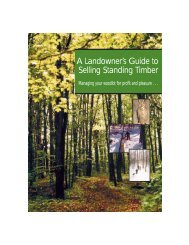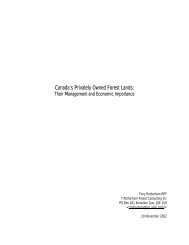A land manager's guide to conserving habitat for forest birds in ...
A land manager's guide to conserving habitat for forest birds in ...
A land manager's guide to conserving habitat for forest birds in ...
You also want an ePaper? Increase the reach of your titles
YUMPU automatically turns print PDFs into web optimized ePapers that Google loves.
conk — hard bracket or shelf fungi found on decl<strong>in</strong><strong>in</strong>g or dead<br />
trees. These resemble mushrooms and <strong>in</strong>vade through tree<br />
wounds, caus<strong>in</strong>g the wood <strong>to</strong> rot. Conks vary <strong>in</strong> size, colour, and<br />
tree location.<br />
connectivity — the degree <strong>to</strong> which <strong>habitat</strong> patches are l<strong>in</strong>ked<br />
across the <strong>land</strong>scape. A <strong>land</strong>scape feature that facilitates the<br />
movement of biota between blocks of <strong>habitat</strong>, such as hedgerows<br />
or riparian areas, will <strong>in</strong>crease connectivity.<br />
conservation — preservation and careful management of the<br />
environment and of natural resources <strong>to</strong> prevent exploitation,<br />
destruction, and loss of that feature over time.<br />
coppice growth — a method of regeneration <strong>in</strong> which a tree or<br />
shrub sprouts many small shoots from a cut stump.<br />
corridor — l<strong>in</strong>ear and narrow stretches of <strong>land</strong> that connect<br />
dist<strong>in</strong>ct patches on the <strong>land</strong>scape. Corridors provide connectivity<br />
and permit the movement of plant and animal species between<br />
what would otherwise be isolated patches.<br />
critical <strong>habitat</strong> — the specific areas or <strong>habitat</strong> features essential<br />
<strong>to</strong> the survival of a species. Often refers <strong>to</strong> the conservation of<br />
particular natural areas or <strong>habitat</strong> features <strong>for</strong> species at risk.<br />
cup nest — a type of bird nest that is built or woven <strong>in</strong> a cup<br />
shape from plant materials (grasses, roots, stalks, and/or sticks),<br />
hair, mud, and feathers. Most song<strong>birds</strong>, such as rob<strong>in</strong>s and<br />
grosbeaks, construct this type of nest on the ground or <strong>in</strong> trees,<br />
shrubs, or herbaceous plants.<br />
cutt<strong>in</strong>g cycle — under the selection system this is the planned<br />
<strong>in</strong>terval between major partial harvests <strong>in</strong> a stand, often 15–20<br />
years <strong>in</strong> southern Ontario <strong>for</strong>ests.<br />
deciduous — trees and shrubs that loose their leaves each fall.<br />
decl<strong>in</strong><strong>in</strong>g tree — a tree that exhibits signs of poor health, such as<br />
a reduced canopy, dead limbs, or evidence of disease.<br />
degraded wood<strong>land</strong> — any <strong>for</strong>est with reduced ecological<br />
function, productivity, or diversity. Often refers <strong>to</strong> wood<strong>land</strong>s<br />
subjected <strong>to</strong> a his<strong>to</strong>ry of poor management (over-harvest<strong>in</strong>g, high<br />
grad<strong>in</strong>g, diameter-limit, high <strong>in</strong>tensity, or high frequency harvests)<br />
such that large, healthy, fast grow<strong>in</strong>g trees are typically absent.<br />
desiccation — process of be<strong>in</strong>g thoroughly dried out.<br />
diameter at breast height (dbh) — a measure of the diameter of<br />
a tree at 1.3 metres above the ground.<br />
diameter class (size class) — one of the <strong>in</strong>tervals <strong>in</strong><strong>to</strong> which<br />
the range of diameters of trees <strong>in</strong> a <strong>for</strong>est is divided <strong>for</strong> purposes<br />
of classification. These are often done <strong>in</strong> 2 cm <strong>in</strong>crements.<br />
diameter-limit — a method of <strong>for</strong>est harvest<strong>in</strong>g <strong>in</strong> which all trees<br />
larger than a specified diameter are removed. This is not a<br />
recognized silviculture system <strong>in</strong> Ontario.<br />
disperser — an organism that moves from its birth place <strong>to</strong> another<br />
location. For example, a salamander is a poor disperser and tends <strong>to</strong><br />
move with<strong>in</strong> 70 metres from its birth pond. A seed disperser refers<br />
<strong>to</strong> an organism or an environmental fac<strong>to</strong>r, such as w<strong>in</strong>d or water<br />
that carries a seed from one area and deposits it <strong>in</strong> another.<br />
double brood<strong>in</strong>g — the production of two groups of young (i.e.,<br />
broods) <strong>in</strong> one breed<strong>in</strong>g season, by the same pair of adults.<br />
Typically, <strong>birds</strong> build another nest <strong>for</strong> the second brood, and the<br />
male cares <strong>for</strong> the first brood while the female tends her new nest.<br />
downed woody debris (DWD) — any dead woody material, such<br />
as branches, logs, and tree <strong>to</strong>ps on the ground. Nutrient cycl<strong>in</strong>g,<br />
water retention, soil disturbance, soil <strong>for</strong>mation, erosion control,<br />
seedbeds, and wildlife <strong>habitat</strong> are some of the ecological functions<br />
that relate <strong>to</strong> down woody debris.<br />
Dutch elm disease — a fungal disease of elm trees which is spread<br />
by the exotic Asian elm bark beetle. It has devastated native<br />
populations of elms that have not evolved resistance <strong>to</strong> the disease.<br />
early successional <strong>for</strong>est — an early successional <strong>for</strong>est is the<br />
<strong>for</strong>est that becomes established immediately follow<strong>in</strong>g a<br />
disturbance or the abandonment of <strong>land</strong> from other uses such as<br />
farm<strong>in</strong>g. It is often characterized by widely distributed, fast<br />
grow<strong>in</strong>g, shade <strong>in</strong><strong>to</strong>lerant shrub and tree species.<br />
ecological function — the <strong>in</strong>dividual or collective role each<br />
species per<strong>for</strong>ms <strong>in</strong> an ecosystem which alters the surround<strong>in</strong>g<br />
biotic and abiotic environment. This is <strong>in</strong>fluenced by species<br />
abundance, fitness, and viability. For example, high abundances<br />
of white-tailed deer, who function as herbivores, can alter plant<br />
communities by excessive brows<strong>in</strong>g, which disturbs the plant<br />
breed<strong>in</strong>g function and can result <strong>in</strong> the loss of certa<strong>in</strong> plant<br />
species or trees and their specific roles (functions), i.e., erosion<br />
control or nest<strong>in</strong>g <strong>habitat</strong>.<br />
ecological <strong>in</strong>tegrity — the ability of an ecosystem <strong>to</strong> function<br />
and cont<strong>in</strong>ue <strong>to</strong> provide natural goods and services while<br />
ma<strong>in</strong>ta<strong>in</strong><strong>in</strong>g biodiversity.<br />
ecological trap — an area of falsely attractive <strong>habitat</strong> preferentially<br />
selected by a species, result<strong>in</strong>g <strong>in</strong> poor survival and reproductive<br />
success. This typically occurs when the environment changes<br />
rapidly so that cues used <strong>for</strong> <strong>habitat</strong> selection are no longer reliably<br />
associated with high quality <strong>habitat</strong>.<br />
ecologist — a person who studies ecology. See ecology.<br />
ecology — the study of the distribution and abundance of life<br />
and the <strong>in</strong>teractions between organisms and their natural<br />
environment.<br />
ecosystem — the natural complex of all liv<strong>in</strong>g components, such<br />
as plants and animals, function<strong>in</strong>g <strong>to</strong>gether <strong>in</strong> the abiotic<br />
environment <strong>in</strong> which they live.<br />
edge — the boundary between dissimilar environments or<br />
<strong>habitat</strong>s. In fragmented <strong>land</strong>scapes, edges are typically between<br />
<strong>for</strong>ests and agricultural or developed <strong>land</strong>.<br />
edge effects — a change <strong>in</strong> species composition, physical<br />
conditions, or other ecological fac<strong>to</strong>rs at the boundary between<br />
two ecosystems.<br />
edge specialist — any species associated with, or a specialist of,<br />
edge <strong>habitat</strong>s.<br />
Glossary of Terms 91

















